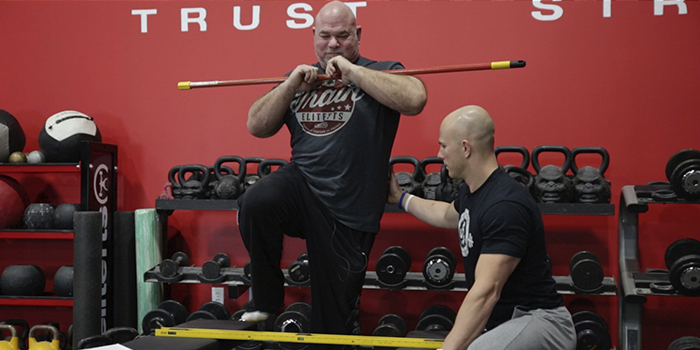
After completing an initial assessment conversation in the first video of this series, Dr. John Rusin and Dave Tate now move to the second step of the process: movement screening. In this video, Dr. Rusin guides Dave through a number of movements designed to help provide more information on the current state of Dave's body. Dr. Rusin describes this set as a "30,000-foot view" from which they look globally at Dave's movement. Aware that it is a very humbling experience for someone with as many issues as Dave, Dr. Rusin points out that this step is not about "passing" or failing" the tests; this part of the process is about determining baseline and gaining as much information as possible.
PART 1: WATCH: Fixing Dave Tate — Initial Assessment with Dr. John Rusin
Dr. Rusin uses seven foundational patterns to measure Dave's capacity for movement and the pain he experiences in various positions. While there is a score for each screen, the focus is on the quality of movement and finding Dave's compensations patterns. The seven main tests are the squat test, hurdle step, in-line lunge, functional internal and external shoulder rotation, active straight-leg raise, push-up test, and quadruped position test.
Squat Test
The first test is a deep squat. The setup begins with the feet shoulder width apart (feet directly below armpits), the toes facing outward, and holding a dowel on top of the head. In this position, the test is to then squat down, pause for one second, and return to standing. For Dave, Dr. Rusin knew the position of the dowel even at the start would be a problem, so he allows him to hold it elsewhere. Dave fails to get into the position, which Dr. Rusin remarks as a "checked box" for knowing for certain what he can't do. Later in the process, Dr. Rusin will compare this assessment to Dave's foundational movement pattern development and the way he normally squats.
Hurdle Step
Dr. Rusin points out that this test is of particular importance for Dave because, as he mentioned in the initial assessment, he experienced great results in the past by elevating his heel several inches and doing step-ups. Additionally, he shared that he isn't currently training single-leg stance work and is having issues with his hip, groin, and lower back.
For this test, with knees together and feet straight, Dave is instructed to lift one leg over a line, touch the floor, and then step back. Dave makes an adjustment with the bar in front of him because he is again unable to get into the standard position. Rusin makes several key observations, most notably that Dave objectively completes the movement, but subjectively he does so through a number of troubling compensation patters. These compensation patterns will become priorities for future training adjustments.
In-Line Lunge
For this test, Dave starts in a split squat stance with a narrow base. After making measurements particularly for Dave's body, Rusin instructs Dave to touch his back knee to the ground in a slow, controlled manner. Using the split asymmetrical stance and analyzing each side, Rusin notes Dave's inability to touch his knee down, as well as his inability to keep a vertically angled torso and stack the hips. He also notices that Dave cannot rest on the ground after touching and, rotationally, lacks the ability to get into the right position. Dave reports significant pain in this test, particularly in his knees.
Functional Internal and External Rotation
This test combines multiple positions of the shoulder in one movement. To start by testing external rotation, the legs must be together and the neck, spine, and hips must stay neutral. With an open hand, Dr. Rusin instructs Dave to reach overhead and try to touch his opposite scapula. Then to test functional internal rotation, Dr. Rusin has Dave keep the same position and, with an open hand, go behind his back and attempt to touch the inferior angle of his scapula. Rusin again notes a number of compensations, particularly with the internal rotation test.
Active Straight-Leg Raise
Despite what many people think, this test is not about flexibility or mobility. Dr. Rusin explains that this test is especially useful for showing the body's ability to utilize the core to coordinate with the pelvis to unlock the posterior chain musculature of the body, including the glutes, the hamstrings, and the calves. To setup, Dave lies on his back with his hands on the ground and his toes pointed up. Keeping the knees straight, he then attempts to flex at the hip and raise one leg up as high as he can.
While watching Dave's movement, Dr. Rusin points out that, while it looks like he has good flexibility, there are too many moving parts that help Dave lift his leg. He externally rotates his opposite hip, his hip flexors lift from the ground, his low back comes of the floor, and his lifting leg also rotates. This is problematic because the purpose of the test isn't to see how far you can move but to see how far you can move without compensation. It becomes much more difficult to compensate when you slow down the movement, which is why Rusin repeatedly cues Dave to move more slowly to enable accurate analysis.
Push-Up Test
This test begins by having Dave lie on his stomach and pull his hands down to the height of his forehead. From this position, Dr. Rusin has Dave attempt to do a push-up, which he fails to complete. Moving the hands further down, closer in line to his shoulders, Dave attempts a push-up again, which he is able to do but not without experiencing serious shoulder and elbow pain. Dr. Rusin notes a limiting factor at the torso and the hips rather than at the shoulders. He explains that this movement is useful for analyzing not only the shoulders but also how an athlete's body links up.
Quadruped Position Test
Beginning in a quadruped position, Dr. Rusin has Dave ensure that his wrists are directly under his elbows and shoulders and his knees are directly below his hips. Additionally, he has Dave keep his knees four inches apart and his wrists four inches apart. In a bird dog style movement, he then has Dave extend his opposite leg and arm, and then pull them back in to touch knee to elbow. This again tests the body's ability to "link up." It also puts Dave in terminal extension and flexion at the spine, hips, and shoulders and has balance and motor control component, enabling Dr. Rusin to analyze Dave in a ground-based asymmetrical stance.
Rusin finishes this part of the assessment by putting Dave through several additional functional key movement screens for the shoulders, hips, and lower back. The next step will be putting Dave through further assessments of range of motion with more particular evaluation of the pain response.
By the minute:
- (0:47) The purpose of the functional movement screen
- (3:21) Squat test
- (5:42) Hurdle step
- (9:20) In-line lunge
- (13:12) Functional internal and external rotation
- (17:21) Active straight-leg raise
- (21:16) Push-up test
- (24:40) Quadruped position
- (27:16) Additional movement screens
FIXING DAVE TATE SERIES
- Initial Assessment with Dr. John Rusin
- Movement Screening
- Orthopedic Evaluation
- The Three Areas of Focus Discovered During Initial Evaluation
- Observing Dave's Current Training Capabilities
- Programming the Six-Phase Dynamic Warm-up Sequence
- The Dynamic Warm-Up Sequences for Upper Body and Lower Body










I lack energy and am sore, tight and or in pain most of the time. I don’t know where to start to try and fix me.